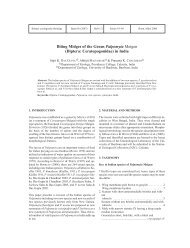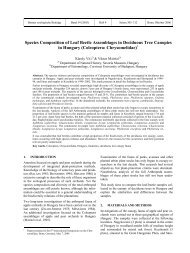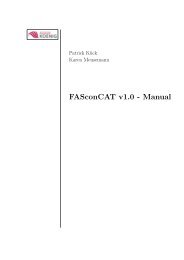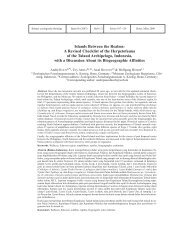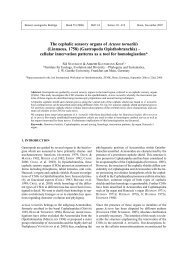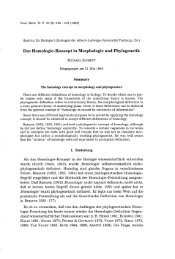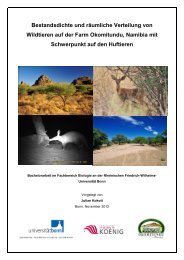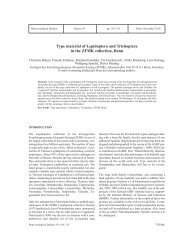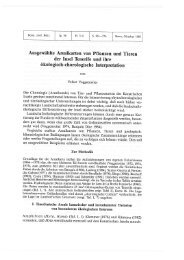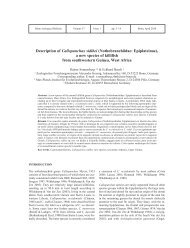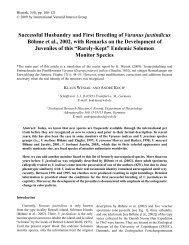Biogeography of the Sacoglossa (Mollusca, Opisthobranchia)*
Biogeography of the Sacoglossa (Mollusca, Opisthobranchia)*
Biogeography of the Sacoglossa (Mollusca, Opisthobranchia)*
You also want an ePaper? Increase the reach of your titles
YUMPU automatically turns print PDFs into web optimized ePapers that Google loves.
256 Ka<strong>the</strong> R. JENSEN: <strong>Biogeography</strong> <strong>of</strong> <strong>Sacoglossa</strong><br />
onymizations, with a few controversial exceptions, will<br />
not be discussed. Only synonymies that have been published<br />
and not subsequently contested are used. Thus<br />
species that have only been mentioned once in <strong>the</strong> literature<br />
are, with few exceptions mentioned in <strong>the</strong> text, considered<br />
valid.<br />
Biogeographic regions and provinces were taken from<br />
BRIGGS (1995) (Fig. 1), and sacoglossan distributions<br />
among <strong>the</strong>se provinces were recorded. Although it must<br />
be assumed that a species occurs continuously between<br />
<strong>the</strong> extreme points <strong>of</strong> distribution, species were only<br />
scored as occurring in a region or province if at least one<br />
published record existed. The number <strong>of</strong> endemic species<br />
was determined for each province. As some regions were<br />
clearly underrepresented with regards to faunistic studies<br />
on opisthobranchs, a few regions have been merged or<br />
deleted from <strong>the</strong> analyses. Similarity between biogeographic<br />
regions or provinces was analyzed using three indices:<br />
CJ= Jaccard’s coefficient= 100(a/(N1+N2-a))<br />
( Valentine 1966), SD= Dice coefficient =<br />
100(2a/(2a+b+c)) (LEAL & BOUCHET 1991), and I=index<br />
<strong>of</strong> inclusion= 100(a/Nmin) (GO L I K O V 1989). These indices<br />
d i ffer in <strong>the</strong> weight placed on shared species (a) compared<br />
to total number <strong>of</strong> species in <strong>the</strong> compared regions (N1,<br />
N2), and species found exclusively in one or <strong>the</strong> o<strong>the</strong>r <strong>of</strong><br />
<strong>the</strong> compared regions (b, c).<br />
3. RESULTS<br />
3.1. Fossil history<br />
After <strong>the</strong> description <strong>of</strong> live specimens <strong>of</strong> bivalved<br />
sacoglossan gastropods (KAWAGUTI & BABA 1959), several<br />
papers on fossil species <strong>of</strong> <strong>the</strong>se sacoglossans appeared.<br />
The first reviews <strong>of</strong> fossil sacoglossans were those<br />
<strong>of</strong> BO E T T G E R (1963) and KAY (1968). There have been extensive<br />
discussions about <strong>the</strong> identity <strong>of</strong> <strong>the</strong> Recent<br />
Tamanovalva, Edenttellina and Midorigai and <strong>the</strong> Middle<br />
Eocene genus Ber<strong>the</strong>linia (e.g. EDMUNDS 1963; BURN<br />
1998). KEEN & SMITH (1961) listed several o<strong>the</strong>r fossil<br />
species and included all in <strong>the</strong> family Juliidae Dall, 1898,<br />
which had previously been located in <strong>the</strong> Bivalvia. More<br />
Fig. 1. Map showing biogeographic regions used in <strong>the</strong> present study. Regions have been modified from BRIGGS (1995). 1. Nor<strong>the</strong>ast<br />
Atlantic. 2. Lusitanian. 3. Mediterranean (including <strong>the</strong> Black Sea). 4. Northwest Atlantic. 5. Caribbean. 6. Southwestern Atlantic<br />
tropical and warm temperate. 7. Aleutian. 8. Oregonian. 9. Californian. 10. Mexican-Panamanian. 11. Sou<strong>the</strong>astern Pacific<br />
warm temperate. 12. Cold temperate South America. 13. Northwest Pacific cold temperate. 14. Northwest Pacific warm temperate.<br />
15. Nor<strong>the</strong>rn and northwestern Australia. 16. Southwestern and sou<strong>the</strong>rn Australia. 17. Sou<strong>the</strong>astern Australia. 18. Nor<strong>the</strong>astern<br />
Australia. 19. Great Barrier Reef. 20. New Zealand. 21. Sou<strong>the</strong>ast Atlantic. 22. Western Indian Ocean. 23. Indo-Polynesian region<br />
(including Ryukyu Islands). 24. Hawaii.




